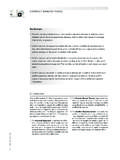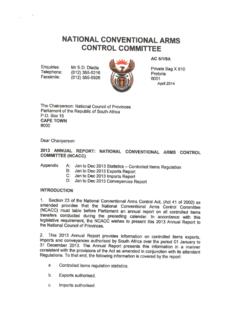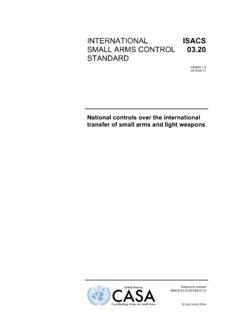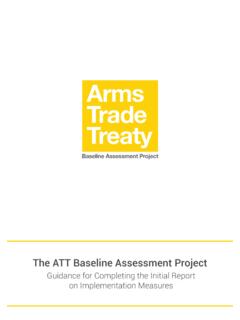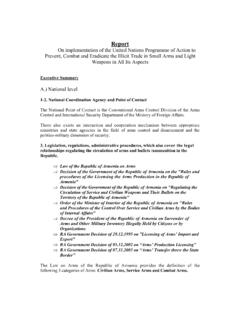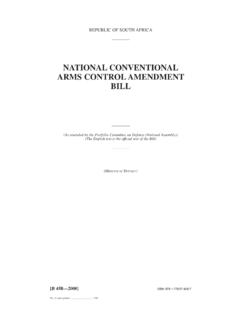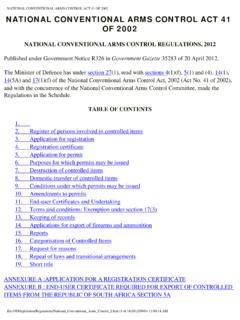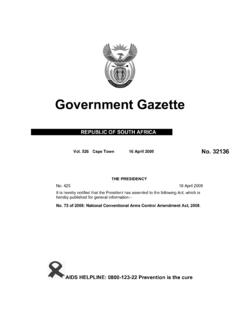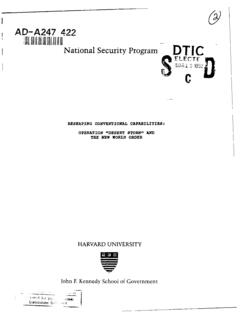Transcription of THE FuTurE oF CoNvENTioNal armS CoNTrol iN EuroPE
1 CSS Analysis in Security PolicyETH ZurichCSSNo. 146 December 2013 2013 Center for Security Studies (CSS), ETH Zurich1 THE FuTurE oF CoNvENTioNal arms CoNTrol iN EuroPEThe regime for CoNvENTioNal arms CoNTrol in EuroPE has been in crisis for several years. a modernization that would adapt CoNvENTioNal arms CoNTrol to the military realities of the 21st century is planned within the framework of the oSCE. This is also an issue for the Swiss oSCE chairmanship in Swiss Foreign minister Didier Bur-khalter, speaking in Dublin in December 2012, first introduced possible topical key issues of the Swiss chairmanship of the organisation for Security and Co-opera-tion in EuroPE (oSCE) in the year 2014, the Swiss daily Neue Z rcher Zeitung ran the following headline: r stungskontrolle jour bringen ( Bringing arms CoNTrol up to date ).
2 The issue of CoNvENTioNal arms CoNTrol in EuroPE is one of ten focal areas selected by the Swiss Federal Department of Foreign affairs (FDFa) for the Swiss oSCE chairmanship in 2014. one topic that is particularly high on the Swiss oSCE agenda is the modernisation of the vi-enna Document (vD) on confidence- and security-building Swiss focus on CoNvENTioNal arms con-trol may be surprising at first glance for two reasons: on the one hand, concerns about military activities being misinter-preted have almost completely disap-peared in EuroPE today, not least due to successful international disarmament and arms CoNTrol measures. The Federal Coun-cil believes that traditional armed conflicts with direct military consequences for Swit-zerland are very unlikely to occur in the next 10 to 15 years.
3 On the other hand, the arms CoNTrol trea-ties and agreements in question were primarily concluded between members of the two main military alliances at the time, NaTo and the Warsaw Pact, includ-ing the most important Treaty on Conven-tional Forces in EuroPE (CFE) of 1990, of which Switzerland is not a member. How-ever, beginning with the early years of the Helsinki Process from 1973 onwards, Swit-zerland, together with other neutral and non-aligned states, has always advocated arms CoNTrol as well as confidence- and security-building measures and on-site in-spections. it is only consistent, therefore, that Switzerland should engage on behalf of a modernisation of the arms CoNTrol re-gime and the principle of cooperative se-curity in EuroPE during its oSCE chairman-ship in 2014.
4 Why CoNvENTioNal arms CoNTrol ?The modernisation of the respective trea-ties and agreements is not considered a top priority today by most European states. The CFE Treaty as an outcome of the Cold War has long served its original purpose as envisaged in 1990, namely, to prevent a large-scale CoNvENTioNal military attack in Central EuroPE or a misinterpre-tation of military manoeuvres in close proximity to a border. Furthermore, the current levels of weapons systems within the oSCE space with the exception of ar-menia and azerbaijan are far below the ceilings permitted under the , especially during the current pe-riod of heightened tensions between rus-sia and the West, tighter national budgets, and resurging nationalism, the issue of cooperative security should remain im-portant.
5 While ceilings for main weapons systems as stipulated by treaty may be obsolete in Western EuroPE today, the fear of armed conflict over territorial claims is still very real in the Southern Caucasus or the Baltic. accordingly, there remains a requirement for verifiable transparency regarding armed forces and limits on de-ployment in sensitive border regions and contested territories. moreover, awareness of the intentions and potentials of other countries armed forces remains crucial even today for preserv-International experts at an OSCE arms CoNTrol inspection. BundeswehrCSS Analysis in Security PolicyNo. 146 December 2013 2013 Center for Security Studies (CSS), ETH Zurich2in russia s side due to the increasing insta-bility on its southern flank in the Caucasus.
6 Accordingly, during the Chechen wars, rus-sia nonchalantly overstepped the agreed force two years of negotiations, the adapted CFE Treaty (aCFE) was signed at the 1999 oSCE summit in istanbul. it was supposed to transcend the Cold War bloc-based thinking by introducing national and territorial force ceilings independently of alliance membership. However, subse-quently, only four states (russia, ukraine, Belarus, and Kazakhstan) ratified the aCFE Treaty. The NaTo states, on the other hand, resisted ratification on political grounds with reference to the istanbul Com-mitments since may 2000: at the 1999 summit, russia had agreed to a complete withdrawal of its troops, equipment, and munitions from the disputed areas of South ossetia and abkhazia (Georgia) as well as Transnistria (moldova).
7 Ever since, under the principle requiring host-state consent to the stationing of foreign troops on its own territory, NaTo believes russia is violating the oSCE rules. until today, this NaTo-imposed linkage between European arms CoNTrol and the resolution of sub-re-gional conflicts in the oSCE space makes it impossible to adapt the CFE to new devel-opments in security suspends the CFE Treatyafter having failed in the attempt to adapt the arms CoNTrol regime to the continu-ing eastward expansion of NaTo, russia suspended the CFE Treaty on 11 December 2007. While the treaty does allow for the possibility of withdrawing from it should unusual developments jeopardise the national interest at the highest levels, a suspension of the treaty is not envisaged.
8 The uS and the other NaTo states as well as Georgia and moldova responded to the russian move at the end of 2011 by decid-ing not to pass on any more military in-formation to russia either in the FuTurE . However, all other CFE member states have continued the activities stipulated under the treaty after 2007. also, a certain degree of transparency vis- -vis russia is still guaranteed, since Belarus can be as-sumed unofficially to be passing on to moscow the military deployment figures and inspection reports it exchanges with the NaTo spring of 2011, after consistently de-manding a modernisation of the CFE Treaty and the adaptation of the old treaty ties. Staff positions have been successively abolished rather than reappointing ex-perts when positions are vacated, leaving states unable to support the safety with less armsThe arms CoNTrol regime as well as the system of confidence- and security-build-ing measures in the oSCE space basically rest on two key pillars: on the one hand, the CFE Treaty of 1990 between the NaTo member states at the time and the War-saw Pact; on the other hand, the vD of 1990, which was approved by the then 35 CSCE states.
9 These are complemented by additional treaties such as the Treaty on open Skies of 1992, which facilitates and regulates reconnaissance purpose of the CFE Treaty of 1990, which is still in effect, was to create a se-cure and stable low-level balance of con-ventional forces in EuroPE and to eliminate the possibility of surprise attacks and large-scale of-fensive operations in Eu-rope. The legally binding treaty limited the number of offensive main weap-ons systems in EuroPE and stipulated mu-tual detailed reporting on force levels and intrusive on-site inspections. The force ceilings, which covered five categories (tanks, armoured fighting vehicles, artil-lery systems, combat aircraft, and combat helicopters), were equal for both sides.
10 In the years after 1990, the treaty led to the elimination of more than 60 000 main weapons systems and the reduction of the massive CoNvENTioNal superiority of the Soviet union/russia in EuroPE . The CFE Treaty had an important role in safeguard-ing Germany s reunification, the dissolu-tion of the Warsaw Pact, and the demise of the Soviet union, creating an unprecedent-ed level of transparency regarding military assets that remains a singular achieve-ment even , as early as 1994, russia demand-ed that the treaty be adapted because of the imminent eastward expansion of NaTo, which had made obsolete the bal-ance between East and West that formed the basis of the treaty.
